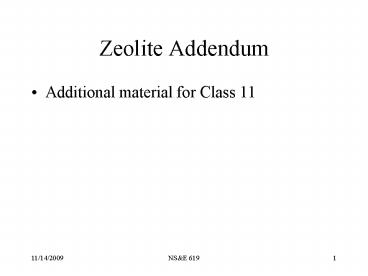Zeolite Addendum - PowerPoint PPT Presentation
1 / 8
Title:
Zeolite Addendum
Description:
10/11/09. NS&E 619. 1. Zeolite Addendum. Additional material for Class 11. 10/11/09. NS&E 619 ... Zeolite text or handbook, origin unknown ... – PowerPoint PPT presentation
Number of Views:127
Avg rating:3.0/5.0
Title: Zeolite Addendum
1
Zeolite Addendum
- Additional material for Class 11
2
Handouts
- Zeolite text or handbook, origin unknown
- Preprint Comparison of Materials for Making
Hydroceramic Waste Forms, D. D. Siemer, M. W.
Grutzeck, and B. E. Scheetz - Why Hydroceramic Solidification Makes More Sense
Than Vitrification For Ineel High Level Waste, D.
D. Siemer - Zeolite Review Brief commentary on zeolites as
a HLW form, G. Beitel - Zeolite Materials, pdf file from Penn State
- Paper on manufacturing glass from Titanite
zeolite - 1972 NAS Evaluation of SRP HLW, Interesting
Historical Summary
3
Zeolites
- The zeolites are a popular group of minerals for
collectors and an important group of minerals for
industrial and other purposes. They combine
rarity, beauty, complexity and unique crystal
habits. Typically forming in the cavities, or
vesicles, of volcanic rocks, zeolites are the
result of very low grade metamorphism. Some form
from just subtle amounts of heat and pressure and
can just barely be called metamorphic while
others are found in obviously metamorphic
regimes. Zeolite crystals have been grown on
board the space shuttle and are undergoing
extensive research into their formation and
unique properties. - The zeolites are framework silicates consisting
of interlocking tetrahedrons of SiO4 and AlO4.
In order to be a zeolite the ratio (Si Al)/O
must equal 1/2. The alumino-silicate structure
is negatively charged and attracts the positive
cations that reside within. Unlike most other
tectosilicates, zeolites have large vacant spaces
or cages in their structures that allow space for
large cations such as sodium, potassium, barium
and calcium and even relatively large molecules
and cation groups such as water, ammonia,
carbonate ions and nitrate ions. In the more
useful zeolites, the spaces are interconnected
and form long wide channels of varying sizes
depending on the mineral. These channels allow
the easy movement of the resident ions and
molecules into and out of the structure.
Zeolites are characterized by their ability to
lose and absorb water without damage to their
crystal structures. The large channels explain
the consistent low specific gravity of these
minerals.
4
Minerals
- Scolecite CaAl2Si3O10-3H2O, Hydrated calcium
aluminum silicate - ChabaziteCaAl2Si4O12 - 6H2O, Hydrated calcium
aluminum silicate - Laumonite Ca(4) Al(8) Si(16) O(48).16H2O
Hydrated calcium aluminum silicate - Analcime NaAlSi2O6-H2O, Hydrated sodium aluminum
silicate - Natrolite Na2Al2Si3O10-2H2O, Hydrated sodium
aluminum silicate - Stilbite NaCa2Al5Si13O36 -14H2O, Hydrated sodium
calcium aluminum silicate - Heulandite (Ca, Na)2 - 3Al3(Al, Si)2Si13O36 -
12H2O, Hydrated calcium sodium aluminum silicate - Mesolite Na2Ca2Al6Si9O30 - 8H2O, Hydrated sodium
calcium aluminum silicate - Phillipsite KCaAl3Si5O16 - 6H2O, Hydrated
potassium calcium aluminum silicate. - Harmotome BaAl2Si6O16 - 6H2O, Hydrated barium
aluminum silicate - etc.
5
Observations
- All zeolites have waters of hydration
- If the water is driven off, the zeolite is
transformed to a Feldspar (a German word for
field rock, i.e., a common rock - The most common feldspar is NaAlSi3O8, Sodium
aluminum silicate - If a water is transformed to a hydroxl, OH-,
probably with the loss of sodium also, the
zeolite transforms to a clay, for example, - Kaolinite Al2Si2O5(OH)4 Aluminum Silicate
Hydroxide
6
Observations Continued
- It is this interchange and relationship to long
term natural analogues that make zeolites
interesting for waste management - If they pick up water they behave like clays
which have a strong attraction for metal ions - If they lose water they become more feldspathoid
(rock like) - If they just hold the water, as zeolites they are
geologically stable and a powerful ion exchange
media
7
Cl and Nitrate
- Cancrinite and Sodalite
- Close relatives of zeolites both contain
chlorine (Cl-) Cancrinite is hydrated and
sodalite contains no H2O or OH- - There are no minerals which contain NO3- with the
sole exception of NaNO3 and KNO3
8
Synthesis of Zeolite (paper handout)
- This is a difficult paper to read, but provides
the details of past attempts in the non-waste
world to synthesize zeolites. - Hundreds of zeolites have been synthesized
- Key points
- Temperatures less than 500C, most often less than
200C, some as low as 100C - Typical ingredients
- NaOH
- Silica Gel
- Diatomite
- Sodium Silicate
- Clays and glass
- Water as steam
- Both Calcium and Sodium based zeolites have been
prepared































